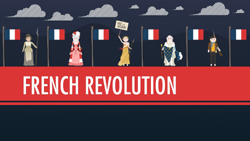| As European countries formed alliances and increased
the sizes of their armed forces, they set the stage for a global war. All
they needed was a good reason to mobilize troops. Another crisis in the
Balkans in the summer of 1914 led directly to the conflict. When a Serbian
terrorist assassinated Archduke Francis Ferdinand and his wife, the powder
keg exploded.
Causes of the War
-
Nationalism, militarism, and a system of alliances contributed
to the start of World War I.
Nineteenth-century liberals believed that if European states
were organized along national lines, these states would work together and
create a peaceful Europe. They were wrong. The system of nation-states
that emerged in Europe in the last half of the nineteenth century led not
to cooperation but to competition.
Nationalism and Alliances
Rivalries over colonies and trade grew during an age
of frenzied nationalism and imperialist expansion. At the same time, Europe’s
great powers had been divided into two loose alliances. Germany, Austria-Hungary,
and Italy formed the Triple Alliance in 1882. France, Great
Britain, and Russia created the Triple Entente in 1907.
In the early years of the twentieth century, a series
of crises tested these alliances. Especially troublesome were the crises
in the Balkans between 1908 and 1913. These events left European states
angry at each other and eager for revenge. Self-interest and success guided
each state. They were willing to use war to preserve their power.
Nationalism in the nineteenth century had yet another
serious result. Not all ethnic groups had become nations. Slavic minorities
in the Balkans and the Hapsburg Empire, for example, still dreamed of their
own national states. The Irish in the British Empire and the Poles in the
Russian Empire had similar dreams.
Internal Dissent
National desires were not the only source of internal
strife at the beginning of the 1900s. Socialist labor movements also had
grown more powerful. The Socialists were increasingly inclined to use strikes,
even violent ones, to achieve their goals. Some conservative leaders, alarmed
at the increase in labor strife and class division, feared that European
nations were on the verge of revolution. This desire to suppress internal
disorder may have encouraged various leaders to take the plunge into war
in 1914.
Militarism
The growth of mass armies after 1900 heightened the existing
tensions in Europe. These large armies made it obvious that if war did
come, it would be highly destructive.
Most Western countries had established conscription,
a military draft, as a regular practice before 1914. (The United States
and Britain were exceptions.) European armies doubled in size between 1890
and 1914. Militarism—the aggressive preparation for war—was
growing. As armies grew, so too did the influence of military leaders.
They drew up vast and complex plans for quickly mobilizing millions of
soldiers and enormous quantities of supplies in the event of war.
Fearing that any changes would cause chaos in the armed
forces, military leaders insisted that their plans could not be altered.
This
left European political leaders with little leeway. In 1914 they had to
make decisions for military instead of political reasons.
What were some major causes of
World War I?
REVIEW & DO
NOW
Answer the following questions in your spiral notebooks: |
| Who were the members of the Triple Alliance? When
was it formed (that is, when did the third state join)?
Who were the members of the Triple Entente? When
was it formed? |
What is conscription?
What happened to the size of European armies between 1890
& 1914?
What is militarism? |
|
|
The German ambassador at Vienna described Austria’s reaction
to the assassination:
“Here I hear even serious people express the
desire of settling accounts with the Serbs once for all. A series of conditions
should be sent to the Serbs, and if they do not accept these, energetic
steps should be taken.”
— Dispatch from the German ambassador at
Vienna, July 10, 1914
The Outbreak of War
-
Serbia’s determination to become a large, independent state
angered Austria-Hungary and started hostilities.
Militarism, nationalism, and the desire to stifle internal
dissent may all have played a role in the starting of World War I. However,
it was the decisions that European leaders made in response to a crisis
in the Balkans that led directly to the conflict.
Assassination in Sarajevo
By 1914, Serbia, supported by Russia, was
determined to create a large, independent Slavic state in the Balkans.
Austria-Hungary, which had its own Slavic minorities to contend with, was
equally determined to prevent that from happening.
On June 28, 1914, Archduke Francis Ferdinand,
the heir to the throne of Austria-Hungary, and his wife Sophia visited
the city of Sarajevo (sar•uh•YAY•voh) in Bosnia.
A group of conspirators waited there in the streets.
In that group was Gavrilo Princip, a 19-year-old
Bosnian Serb. Princip was a member of the Black Hand, a Serbian
terrorist organization that wanted Bosnia to be free of Austria-Hungary
and to become part of a large Serbian kingdom. An assassination attempt
earlier that morning by one of the conspirators had failed. Later that
day, however, Princip succeeded in fatally shooting both the archduke and
his wife.
Austria-Hungary Responds
The Austro-Hungarian government did not know whether
or not the Serbian government had been directly involved in the archduke’s
assassination, but it did not care. Austrian leaders wanted to attack Serbia
but feared that Russia would intervene on Serbia’s behalf. So, they asked
for—and received—the backing of their German allies. Emperor William
II of Germany gave Austria-Hungary a “blank check,” promising Germany’s
full support if war broke out between Russia and AustriaHungary.
On July 28, Austria-Hungary declared war on Serbia.
Russia Mobilizes
Russia was determined to support Serbia’s cause. On July
28, Czar Nicholas II ordered partial mobilization of the
Russian army against Austria-Hungary. Mobilization is the
process of assembling troops and supplies for war. In 1914, mobilization
was considered an act of war.
Leaders of the Russian army informed the czar that they
could not partially mobilize. Their mobilization plans were based on a
war against both Germany and AustriaHungary. Mobilizing against only Austria-Hungary,
they claimed, would create chaos in the army. Based on this claim, the
czar ordered full mobilization of the Russian army on July 29, knowing
that Germany would consider this order an act of war.
The Conflict Broadens
Indeed, Germany reacted quickly. The German government
warned Russia that it must halt its mobilization within 12 hours. When
Russia ignored this warning, Germany declared war on Russia on August 1.
Like the Russians, the Germans had a military plan. General
Alfred von Schlieffen (SHLEE•fuhn) had helped draw up the plan,
which was known as the Schlieffen Plan. It called for a two-front
war with France and Russia since the two had formed a military alliance
in 1894. According to the Schlieffen Plan, Germany would conduct a small
holding action against Russia while most of the German army would carry
out a rapid invasion of France. This meant invading France by moving quickly
along the level coastal area through Belgium. After France was defeated,
the German invaders would move to the east against Russia.
Under the Schlieffen Plan, Germany could not mobilize
its troops solely against Russia. Therefore, it declared war on France
on August 3. About the same time, it issued an ultimatum to Belgium demanding
that German troops be allowed to pass through Belgian territory.
On August 4, Great Britain declared war on Germany for
violating Belgian neutrality. In fact, Britain, which was allied with France
and Russia, was concerned about maintaining its own world power. As one
British diplomat put it, if Germany and Austria-Hungary won the war, “what
would be the position of a friendless England?”
By August 4, all the Great Powers of Europe were at war.
How did the Schlieffen Plan contribute
to the outbreak of World War I?
REVIEW & DO
NOW
Answer the following questions in your spiral notebooks: |
| What was the Bosnian Crisis? When did it start?
Why were the Balkan states “up for grabs”?
What country was outraged by Austria-Hungary’s move?
Why?
What country saw themselves as protectors of the Slavic
people?
What was Serbia’s ultimate goal?
What country stood in it’s way?
What country supported its ambitions?
Who was the Hapsburg (same family as Marie Antoinette)
heir to the throne of Austria-Hungary?
What was the Black Hand and what was their goal? |
What happened on June 28, 1914? Where was this?
Who was Gavrilo Princip? How old was he?
Who was emperor of Germany?
(Were Germany and Austria two separate countries?)
What happened on July 28, 1914?
What was Czar Nicholas II’s response?
What is mobilization?
How did the military leaders of Russia advise the czar?
What happened on August 1, 1914?
What was the Schlieffen Plan?
What happened on August 3?
What happened on August 4? |
|
|
|





